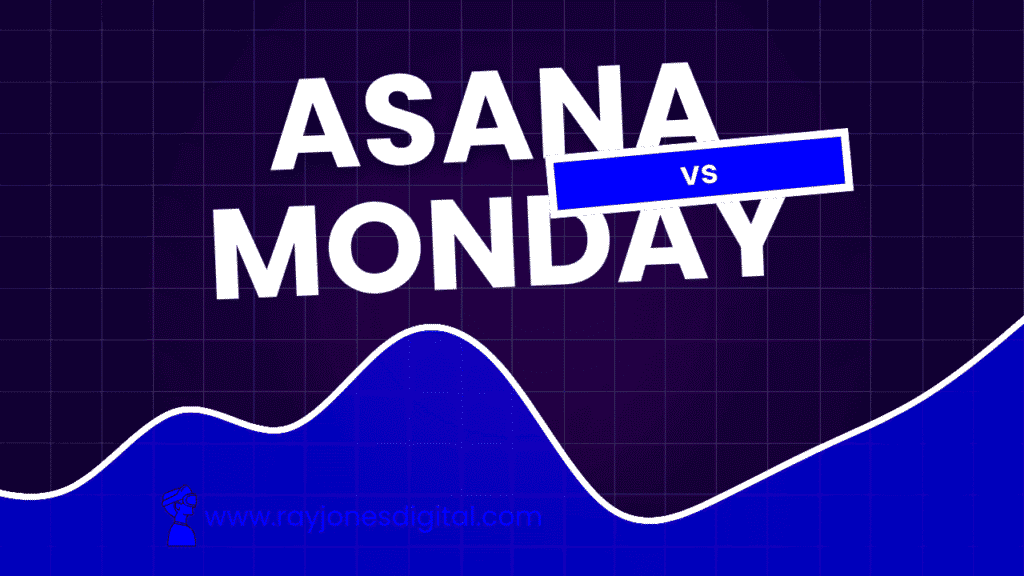
Project management platforms have become essential for teams seeking to streamline workflows and boost productivity. Asana vs Monday.com represent two leading solutions, each offering distinct approaches to task management, team collaboration, and project tracking.
This comprehensive comparison examines both platforms across crucial factors including features, pricing, user experience, and practical applications. You’ll discover which tool aligns best with your team’s workflow requirements and business objectives.
What is Asana?
Asana emerged as a task-focused project management platform designed to help teams organise, track, and manage their work. The tool emphasises simplicity and clarity, offering multiple project views including lists, boards, timeline, and calendar formats.
The platform’s strength lies in its intuitive task management system and robust collaboration features. Teams can break down complex projects into manageable tasks, assign responsibilities, set deadlines, and track progress through various visualisation methods.
Asana integrates with over 200 applications including Slack, Google Workspace, Adobe Creative Suite, and Salesforce. This extensive integration ecosystem allows teams to centralise their workflows and reduce the need for constant platform switching.
What is Monday.com?
Monday.com operates as a highly customisable work operating system that adapts to various team structures and project types. The platform uses a colourful, visual approach with customisable boards, columns, and automation features.
The tool’s flexibility allows teams to create tailored workflows for different departments, from marketing campaigns and product development to HR processes and customer relationship management. Monday.com’s visual design makes project status and progress immediately apparent to all team members.
Beyond basic project management, Monday.com includes features like time tracking, resource management, advanced reporting, and workflow automation. This comprehensive approach positions it as a complete business management solution rather than just a project management tool.
Feature Comparison
Task Management and Organisation
Asana provides elegant task management with subtasks, dependencies, custom fields, and multiple project views. The platform excels at breaking down complex projects into manageable components whilst maintaining clear hierarchies and relationships between tasks.
Monday.com offers flexible task organisation through customisable boards and columns. Teams can create unique structures for different project types, with colour-coding and status indicators providing instant visual feedback on progress.
Winner: Asana (for pure task management simplicity)
Customisation and Flexibility
Asana offers reasonable customisation options including custom fields, project templates, and various view formats. However, the platform maintains a more structured approach that may limit extreme customisation needs.
Monday.com provides extensive customisation capabilities, allowing teams to create entirely unique workflows, dashboards, and automation rules. The platform adapts to virtually any business process or project structure.
Winner: Monday.com
Collaboration Features
Asana includes proofing tools, commenting systems, team messaging, and project status updates. The platform facilitates clear communication through task-specific conversations and team-wide announcements.
Monday.com offers collaborative features including file sharing, team updates, and communication tools. The visual nature of the platform makes it easy for team members to understand project status and contribute effectively.
Winner: Asana (for communication clarity)
Reporting and Analytics
Asana provides portfolio management, custom dashboards, and progress tracking across multiple projects. The platform offers insights into team workload, project timelines, and completion rates.
Monday.com delivers comprehensive reporting with customisable dashboards, advanced analytics, and performance metrics. The platform’s visual reporting tools make complex data easily digestible for stakeholders.
Winner: Monday.com
Automation Capabilities
Asana includes basic automation features such as task creation rules, assignment automation, and deadline reminders. These features help reduce manual administrative work whilst maintaining project momentum.
Monday.com offers extensive automation options with hundreds of pre-built automation recipes and the ability to create custom automation workflows. The platform can automate complex multi-step processes across different boards and projects.
Winner: Monday.com
Mobile Experience
Asana provides a robust mobile application with full task management capabilities, offline access, and push notifications. The mobile interface maintains the platform’s clean, intuitive design whilst offering complete functionality.
Monday.com’s mobile app offers good functionality with visual project boards, task management, and communication features. However, some advanced customisation options are limited on mobile devices.
Winner: Asana
Pricing Analysis
Asana Pricing
Asana offers several subscription tiers:
- Basic (Free): Up to 15 team members, basic features
- Premium (£8.99/user/month): Timeline view, custom fields, advanced search
- Business (£21.99/user/month): Portfolios, workload management, advanced integrations
- Enterprise (Contact for pricing): Admin controls, data export, priority support
Monday.com Pricing
Monday.com uses a per-seat pricing model:
- Basic (£6/user/month): Core features, 5GB storage
- Standard (£8/user/month): Timeline view, calendar, guest access
- Pro (£12/user/month): Time tracking, formula columns, private boards
- Enterprise (£16/user/month): Advanced security, multi-level permissions
Value Assessment
Asana’s free tier provides substantial value for small teams, including essential project management features without cost limitations. The premium tiers offer good value for teams requiring advanced features and integrations.
Monday.com’s pricing reflects its comprehensive feature set and customisation capabilities. The investment becomes worthwhile for teams requiring extensive automation and visual project management.
Ease of Use
Asana User Experience
Asana prioritises simplicity with a clean, minimalist interface that reduces cognitive load. New users can quickly understand the platform’s structure and begin managing projects without extensive training.
The platform’s consistent design language across different views and features creates a predictable user experience. Team members can easily switch between list, board, and timeline views whilst maintaining their workflow momentum.
Monday.com User Experience
Monday.com emphasises visual appeal with colourful boards, icons, and status indicators. The platform’s interface is engaging and modern, though the extensive customisation options can initially overwhelm new users.
The visual design makes project status immediately apparent, but mastering the platform’s full capabilities requires more time investment compared to Asana’s streamlined approach.
Use Cases and Target Audiences
When to Choose Asana
Asana benefits teams who:
- Prioritise task management clarity and simplicity
- Need robust collaboration and communication features
- Want extensive integration options with existing tools
- Require strong mobile functionality for remote work
- Focus on traditional project management methodologies
- Prefer a clean, distraction-free interface
When to Choose Monday.com
Monday.com suits organisations that:
- Require extensive customisation and workflow flexibility
- Need comprehensive reporting and analytics capabilities
- Want powerful automation to reduce manual work
- Manage diverse project types across different departments
- Prefer visual project management with immediate status visibility
- Require advanced resource management and time tracking
Limitations and Considerations
Asana Limitations
Asana’s simplicity can become restrictive for teams requiring extensive customisation or complex automation workflows. The platform’s reporting capabilities, whilst adequate, may not satisfy organisations requiring advanced analytics.
The free tier limitations become apparent as teams grow beyond 15 members, necessitating paid subscriptions for continued collaboration.
Monday.com Limitations
Monday.com’s extensive customisation options can lead to over-complicated workflows if not properly managed. The platform’s visual approach may not suit all team preferences or project types.
The pricing structure means costs can escalate quickly for larger teams, particularly when accessing advanced features across multiple pricing tiers.
Integration Ecosystems
Asana Integrations
Asana offers over 200 integrations including popular tools like Slack, Microsoft Teams, Google Workspace, Adobe Creative Cloud, and Salesforce. The platform’s API allows for custom integrations and workflow automation.
Native integrations typically provide deep functionality, allowing teams to manage projects directly from their preferred communication or creative tools.
Monday.com Integrations
Monday.com provides extensive integration options with popular business tools, though the selection is smaller than Asana’s ecosystem. The platform compensates with powerful automation capabilities that can connect different systems.
The platform’s API and automation features enable complex workflows that span multiple applications and business processes.
Security and Compliance
Asana Security
Asana provides enterprise-grade security with features including two-factor authentication, data encryption, SOC 2 compliance, and GDPR compliance. The platform offers admin controls for user management and data governance.
Monday.com Security
Monday.com includes comprehensive security features such as two-factor authentication, data encryption, SOC 2 compliance, and enterprise-grade admin controls. The platform also offers IP restrictions and audit logs for enhanced security monitoring.
Making Your Strategic Choice
The decision between Asana and Monday.com depends on your team’s specific requirements, project complexity, and workflow preferences.
Choose Asana if your priority is straightforward task management with excellent collaboration features and extensive integrations. The platform excels for teams wanting to implement project management quickly without extensive customisation requirements.
Choose Monday.com if you need a highly customisable work operating system with powerful automation and visual project management capabilities. The platform suits organisations requiring flexibility to adapt the tool to their unique business processes.
Optimising Your Project Management Success
Both platforms offer free trials, enabling you to test their capabilities with your specific project requirements. Consider your team size, project complexity, integration needs, and budget constraints when making your decision.
The most successful project management implementations combine the right tool with clear processes and team buy-in. Whether you choose Asana, Monday.com, or explore other options, ensure your selected platform aligns with your team’s natural workflow patterns and supports your long-term business objectives.
Remember that project management tools enhance rather than replace good project management practices. Success depends on consistent usage, clear communication, and ongoing refinement of your workflows regardless of which platform you choose.

I am Ray Jones Digital
My current occupations: a Digital Marketer, Local SEO expert, Link Builder, and WordPress SEO specialist. Shopify SEO, Ecommerce Store Management, and HTML & WordPress Developer I have been practicing the above mentioned services for more than 10 years now As an SEO expert working with your ongoing projects.



